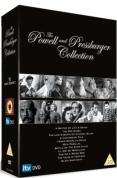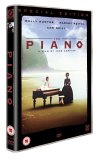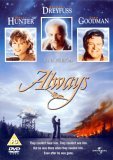![Porky's [1981]](/pictures/1013712.jpg) Porky's | DVD | (17/04/2019)
from £20.10
| Saving you £-7.11 (N/A%)
| RRP
Porky's | DVD | (17/04/2019)
from £20.10
| Saving you £-7.11 (N/A%)
| RRP Keep an eye out for the funniest movie about growing up ever made! This hilarious raunchy comedy hit that spawned two sequels takes an unblushing look at teenage adolescence in the 1950's. It follows the comic misadventures of six high schoolers whose most fervent wish is to find some sexual satisfaction at Porky's a notorious honky-tonk strip joint. When they're ripped off and thrown out by the owner they plot a revengeful scheme that is truly unforgettable!
![The Tree of Life [DVD]](/pictures/1111234.jpg) The Tree of Life | DVD | (31/10/2011)
from £4.59
| Saving you £15.40 (335.51%)
| RRP
The Tree of Life | DVD | (31/10/2011)
from £4.59
| Saving you £15.40 (335.51%)
| RRP The long front lawns of summer afternoons, the flicker of sunlight as it sprays through tree branches, the volcanic surge of the Earth's interior as the planet heaves itself into being--you certainly can't say Terrence Malick lacks for visual expressiveness. The Tree of Life is Malick's long-cherished project, a film that centres on a family in 1950s Waco, Texas, yet also reaches for cosmic significance in the creation of the universe itself. The Texas memories belong to Jack (Sean Penn), a modern man seemingly ground down by the soulless glass-and-metal corporate world that surrounds him. We learn early in the film of a family loss that happened at a later time, but the flashbacks concern only the dark Eden of Jack's childhood: his games with his two younger brothers, his frustrated, bullying father (Brad Pitt), his one-dimensionally radiant mother (Jessica Chastain). None of which unfolds in anything like a conventional narrative, but in a series of disconnected scenes that conjure, with poetry and specificity, a particular childhood realm. The contributions of cinematographer Emmanuel Lubezki and production designer Jack Fisk cannot be underestimated in that regard, and it should be noted that Brad Pitt contributes his best performance: strong yet haunted. And how does the Big Bang material (especially a long, trippy sequence in the film's first hour) tie into this material? Yes, well, the answer to that question will determine whether you find Malick's film a profound exploration of existence or crazy-ambitious failure full of beautiful things. Malick's sincerity is winning (and so is his exceptional touch with the child actors), yet many of the movie's touches are simultaneously gaseous (amongst the bits of whispered narration is the war between nature and grace, roles assigned to mother and father) and all-too-literal (a dinosaur retreats from nearly killing a fellow creature--the first moments of species kindness, or anthropomorphic poppycock?). The Tree of Life premiered at the Cannes Film Festival and won the Palme d'Or there after receiving boos at its press screening. The debate continues, unabated, from that point. --Robert Horton
![The Adventures Of Robin Hood [1938]](/pictures/1001927.jpg) The Adventures Of Robin Hood | DVD | (17/04/2019)
from £10.35
| Saving you £3.64 (35.17%)
| RRP
The Adventures Of Robin Hood | DVD | (17/04/2019)
from £10.35
| Saving you £3.64 (35.17%)
| RRP Dashing Errol Flynn is the definitive Robin in 1938's The Adventures of Robin Hood, the most gloriously swashbuckling version of the legendary story. Warner Brothers reunited Michael Curtiz, their top-action director, with the winning team of Flynn and Olivia de Havilland (Maid Marian) and perennial villain Basil Rathbone as the aristocratic Sir Guy of Gisbourne, and pulled out all stops for the production. It became their costliest film to date, a grandly handsome, glowing technicolour adventure set to a stirring, Oscar-winning score by Erich Wolfgang Korngold--music that became a template for countless later movies, notably John Williams' Star Wars and Indiana Jones scores. The decadent Prince John (a smoothly conniving Claude Rains) takes advantage of King Richard's absence to tax the country into poverty but meets his match in the medieval guerrilla rebel Robin Hood and his Merry Men of Sherwood Forest, who rise up and, to quote a cliché coined by the film, "steal from the rich and give to the poor". Stocky Alan Hale Sr plays Robin's loyal friend Little John (a part he played in Douglas Fairbanks' silent version), Eugene Palette plays the portly Friar Tuck and Melville Cooper is the bumbling Sheriff of Nottingham. Flynn's confidence and cocky charm makes for a perfect Robin and his easygoing manner is a marvellous counterpoint to Rathbone's regal bearing and courtly diction. The film climaxes in their rousing battle-to-the-finish sword fight, a magnificently choreographed scene highlighted by Curtiz's inventive use of shadows cast upon the castle walls. --Sean Axmaker
 Powell & Pressburger Boxset | DVD | (20/11/2006)
from £25.84
| Saving you £-1.90 (N/A%)
| RRP
Powell & Pressburger Boxset | DVD | (20/11/2006)
from £25.84
| Saving you £-1.90 (N/A%)
| RRP This box set features a collection of Powell And Pressburger finest films. Includes: 1. The Tales of Hoffman (1951) 2. Black Narcisus (1946) 3. A Matter of Life & Death (1946) 4. The Life & Death of Colonel Blimp (1943) 5. A Canterbury Tale (1944) 6. I Know Where I am Going (1945) 7. 49th Parallel (1941) 8. The Battle of the River Plate (1956) 9. Ill Met By Moonlight (1957) 10. They're A Weird Mob (1966) 11. The Red Shoes (1948)
![Henry: Mind of a Tyrant [DVD]](/pictures/1092847.jpg) Henry: Mind of a Tyrant | DVD | (17/04/2019)
from £10.49
| Saving you £9.50 (90.56%)
| RRP
Henry: Mind of a Tyrant | DVD | (17/04/2019)
from £10.49
| Saving you £9.50 (90.56%)
| RRP This four-part television biography of Henry VIII is presented by historian Dr David Starkey who takes us inside the mind of one of the most famous rulers of all time.
![The Big Sick [DVD] [2017]](/pictures/1144820.jpg) The Big Sick | DVD | (20/11/2017)
from £3.98
| Saving you £N/A (N/A%)
| RRP
The Big Sick | DVD | (20/11/2017)
from £3.98
| Saving you £N/A (N/A%)
| RRP Based on the real-life courtship between Kumail Nanjiani and Emily V. Gordon, THE BIG SICK tells the story of Pakistan-born aspiring comedian Kumail (Nanjiani), who connects with grad student Emily (Kazan) after one of his standup sets. However, what they thought would be just a one-night stand blossoms into the real thing, which complicates the life that is expected of Kumail by his traditional Muslim parents. When Emily is beset with a mystery illness, it forces Kumail to navigate the medical crisis with her parents, Beth and Terry (Holly Hunter and Ray Romano) who he's never met, while dealing with the emotional tug-of-war between his family and his heart.
 The Vital Spark | DVD | (27/02/2006)
from £8.97
| Saving you £1.02 (11.37%)
| RRP
The Vital Spark | DVD | (27/02/2006)
from £8.97
| Saving you £1.02 (11.37%)
| RRP JOIN THE original crew of the good ship Vital Spark on their precarious voyage of life through the uncharted seas of change. Or more precisely - up and down the Clyde.In A Drop o' the Real Stuff wily Captain Para Handy gets the crew involved in whisky smuggling and in Bad Luck Cargo never the one to miss an opportunity the Cap'n takes possession of an unwanted headstone with a view to making a killing on the resale.It's near mutiny when the crew of the Vital Spark are invited to the wedding of the year - all except Dan... having been at sea for a considerable time it's inevitable that the odd Quarrel will break out. And the sparks really fly when the Cap'n gives Dan his jotters - is it the end of the line for the Vital Spark and her crew?Finally enjoy a Highland Voyage with the crew old and new aboard the steamer as she takes a musical journey around the Scottish isles.A welcome return for an old comedy classic which truly has stood the test of time and is a must for any connoisseur of classic Scottish comedy.The only remaining episodes of the classic BBC series.
![O Brother Where Art Thou? [Blu-ray] [2000]](/pictures/1120342.jpg) O Brother Where Art Thou? | Blu Ray | (12/08/2013)
from £9.38
| Saving you £5.61 (59.81%)
| RRP
O Brother Where Art Thou? | Blu Ray | (12/08/2013)
from £9.38
| Saving you £5.61 (59.81%)
| RRP Only Joel and Ethan Coen, masters of quirky and ultra-stylish genre subversion, would dare nick the plotline of Homer's Odyssey for O Brother, Where Art Thou?, their comic picaresque saga about three cons on the run in 1930s Mississippi. Our wandering hero in this case is one Ulysses Everett McGill, a slick-tongued wise guy with a thing for hair pomade (George Clooney, blithely sending up his own dapper image) who talks his chain-gang buddies (Coen-movie regular John Turturro and newcomer Tim Blake Nelson) to light out after some buried loot he claims to know of. En route they come up against a prophetic blind man on a railroad truck, a burly one-eyed baddie (the ever-magnificent John Goodman), a trio of sexy singing ladies, a blues guitarist who's sold his soul to the devil, a brace of crooked politicos on the stump, a manic-depressive bank robber, and--well, you get the idea. Into this, their most relaxed film yet, the Coens have tossed a beguiling ragbag of inconsequential situations, a wealth of looping, left-field dialogue and a whole stash of gags both verbal and visual. O Brother (the title's lifted from Preston Sturges' classic 1941 comedy Sullivan's Travels) is furthermore graced with glowing, burnished photography from Roger Deakins and a masterly soundtrack from T-Bone Burnett that pays loving homage to American 30s folk-styles: blues, gospel, bluegrass, jazz and more. And just to prove that the brothers haven't lost their knack for bad-taste humour, we get a Ku Klux Klan rally choreographed like something between a Nuremberg rally and a Busby Berkeley musical. --Philip KempOn the DVD: This two-disc set duplicates the original single-disc release of the film which included a handful of cast and crew interviews, and adds an additional disc with more interviews, two brief behind-the-scenes featurettes about the production design and the post-production digital colouring of the film, a couple of storyboard-to-scene comparisons and a music video of "Man of Constant Sorrow". There's also a 16-minute documentary to promote the companion Down from the Mountain concert. Frankly there's not a lot here to justify spreading it across two discs: a more pleasing not to say generous offering would have been to cram all these extras onto Disc 1 and give us Down from the Mountain as the second disc. --Mark Walker
![The Piano [1993]](/pictures/1020747.jpg) The Piano | DVD | (01/10/1999)
from £6.19
| Saving you £9.80 (158.32%)
| RRP
The Piano | DVD | (01/10/1999)
from £6.19
| Saving you £9.80 (158.32%)
| RRP Jane Campion's The Piano struck a deep chord (if you'll excuse the expression) with audiences in 1993, who were mesmerised by the film's rich, dreamlike imagery. It is the story of a Scottish woman named Ada (Holly Hunter), who has been mute since age 6 because she simply chose not to speak. Ada travels with her daughter Flora (Anna Paquin) and her beloved piano to a remote spot on the coast of New Zealand for an arranged marriage to a farmer (Sam Neill). She gives piano lessons to a gruff neighbor (Harvey Keitel) who has Maori tattoos on his face, and, well, things develop from there. The picture takes on a powerful dream logic that simply defies synopsis. It's a breathtakingly beautiful and original achievement from Campion, a unique stylist. The Piano won the Palme d'Or at the Cannes Film Festival and Oscars for Hunt, Paquin and Campion's screenplay. --Jim Emerson
 The Piano | DVD | (06/02/2006)
from £6.95
| Saving you £13.04 (187.63%)
| RRP
The Piano | DVD | (06/02/2006)
from £6.95
| Saving you £13.04 (187.63%)
| RRP Ada her nine-year-old daughter and her piano arrive to an arranged marriage in the remote bush of nineteenth century New Zealand. Of all her belongings her husband refuses to transport the piano and it is left behind on the beach. Unable to bear its certain destruction Ada strikes a bargain with an illiterate tattooed neighbour. She may earn her piano back if she allows him to do certain things while she plays; one black key for a lesson. The arrangement draws all three deeper in
![Planet of the Apes: Evolution Collection [DVD]](/pictures/1112241.jpg) Planet of the Apes: Evolution Collection | DVD | (12/12/2011)
from £34.99
| Saving you £10.00 (28.58%)
| RRP
Planet of the Apes: Evolution Collection | DVD | (12/12/2011)
from £34.99
| Saving you £10.00 (28.58%)
| RRP Titles Comprise:Planet Of The Apes: Charlton Heston stars as an astronaut lost in a world run by evolved apes in this highly influential, Oscar-winning and epic film! (1968)Beneath The Planet Of The Apes: James Franciscus discovers new horrors on the Planet of the Apes, including a subterranean world of highly advanced humans who worship a WMD! Escape From The Planet Of The Apes: Refugee chimps from the feature, Cornelius and Zira (Roddy McDowall and Kim Hunter), are hunted down as an evolutionary threat in twentieth-century America. (1971)Conquest Of The Planet Of The Apes: In the not-too-distant future, an ape named Caesar (Roddy McDowall) defies his human masters, launching a revolt that will change the way the world is run...and by whom. (1972)Battle For The Planet of The Apes: The peaceful coexistence of man and ape is shattered when militant factions of both species clash, igniting an explosive final conflict! (1973)Rise Of The Planet Of The Apes: Set in present day San Francisco, Rise Of The Planet Of The Apes is a reality-based cautionary tale, a science fiction/science fact blend, where man's own experiments with genetic engineering lead to the development of intelligence in apes and the onset of a war for supremacy.
 Always | DVD | (10/04/2003)
from £9.80
| Saving you £0.19 (1.94%)
| RRP
Always | DVD | (10/04/2003)
from £9.80
| Saving you £0.19 (1.94%)
| RRP Steven Spielberg directs this heartwarming romantic adventure USA Today calls a ""winner"". Pete Sandrich (Richard Dreyfuss) is a legendary pilot with a passion for daredevil firefighting. However Dorinda (Holly Hunter) the woman he loves and Al (John Goodman) Pete's best friend know that legends can't take risks forever. After sacrificing himself to save Al the ace pilot faces his most challenging mission: helping Dorinda move on with her life. Breathtaking cinematography and exhilarating aerial choreography highlight this compelling adventure that co-stars Brad Johnson and features a special appearance by Audrey Hepburn.
![The Piano [1993]](/pictures/1046822.jpg) The Piano | DVD | (10/07/2006)
from £5.98
| Saving you £10.01 (167.39%)
| RRP
The Piano | DVD | (10/07/2006)
from £5.98
| Saving you £10.01 (167.39%)
| RRP Ada her nine-year-old daughter and her piano arrive to an arranged marriage in the remote bush of nineteenth century New Zealand. Of all her belongings her husband refuses to transport the piano and it is left behind on the beach. Unable to bear its certain destruction Ada strikes a bargain with an illiterate tattooed neighbour. She may earn her piano back if she allows him to do certain things while she plays; one black key for a lesson. The arrangement draws all three deeper into a complex emotional sexual bond remarkable for its nave passion and frightening disregard for limits... Winner of 3 Oscars for Best Screenplay (Jane Campion) Best Actress (Holly Hunter) and Best Suporting Actress (Anna Paquin) and 11 awards from the Australian Film Institiute.
![O Brother, Where Art Thou? [2000]](/pictures/1006314.jpg) O Brother, Where Art Thou? | DVD | (09/04/2001)
from £5.71
| Saving you £10.28 (180.04%)
| RRP
O Brother, Where Art Thou? | DVD | (09/04/2001)
from £5.71
| Saving you £10.28 (180.04%)
| RRP George Clooney stars in the latest film from the Coen brothers, a musical about a con on the run in the Deep South of the 1930s.
![The Swimmer [1968]](/pictures/1012473.jpg) The Swimmer | DVD | (26/05/2003)
from £N/A
| Saving you £N/A (N/A%)
| RRP
The Swimmer | DVD | (26/05/2003)
from £N/A
| Saving you £N/A (N/A%)
| RRP Burt Lancaster gives one of his most daringly complex performances in The Swimmer, a fascinating adaptation of John Cheever's celebrated short story. At first it seems that middle-aged businessman Ned Merrill (Lancaster) is merely enjoying a spontaneous adventure, swimming from pool to pool among the well-tended estates of his affluent Connecticut neighbourhood. But as Ned encounters a variety of neighbours, we see from their reactions that he's on an entirely different kind of journey, balanced on the edge of some mysterious psychosis that we can't fully understand until the film's final, devastating image. A compelling portrait of loss, refracted memories, and deep-rooted emotional denial, The Swimmer sprung from the same late-60s soil that yielded similarly ground-breaking literary films such as The Graduate and Goodbye, Columbus. It's an egotistical showcase for the physical prowess of its 55-year-old star, but Lancaster turns it into something deeper, more disturbing, and completely unforgettable. --Jeff Shannon
![The Gaffer - The Complete Series [DVD]](/pictures/1104070.jpg) The Gaffer - The Complete Series | DVD | (11/10/2010)
from £26.92
| Saving you £-1.93 (N/A%)
| RRP
The Gaffer - The Complete Series | DVD | (11/10/2010)
from £26.92
| Saving you £-1.93 (N/A%)
| RRP Bill Maynard (Oh No It's Selwyn Froggitt!) is Fred Moffat the tight-fisted yet quick-thinking director of a struggling light-engineering firm in this cleverly scripted bittersweet sitcom which regularly attracted audiences of over 16 million. The recession is biting and the Gaffer finds himself under siege from the taxman his creditors his bank manager... and just about everyone else. He sometimes resorts to extreme measures to keep his head above water and is permanently at odds with militant shop steward Harry (Russell Hunter - Callan). But glamorous secretary Betty (Pat Ashton) is always around to lighten the mood - even if she rarely succeeds in getting Harry and Fred to see eye-to-eye... Presented here are all three series of this hugely popular sitcom from Yorkshire Television.
![Always [Blu-ray] [2015] [Region Free]](/pictures/1135151.jpg) Always | Blu Ray | (04/05/2015)
from £17.18
| Saving you £2.81 (16.36%)
| RRP
Always | Blu Ray | (04/05/2015)
from £17.18
| Saving you £2.81 (16.36%)
| RRP Considered by many to represent a low point in Steven Spielberg's career, 1990's Always did suggest something of a temporary drift in the director's sensibility. A remake of the classic Spencer Tracy film A Guy Named Joe, Always stars Richard Dreyfuss as a Forest Service pilot who takes great risks with his own life to douse wildfires from a plane. After promising his frightened fiancée (Holly Hunter) to keep his feet on the ground and go into teaching, Dreyfuss's character is killed during one last flight. But his spirit wanders restlessly, hopelessly attached to and possessive of Hunter, who can't see or hear him. Then the real conflict begins: a trainee pilot (Brad Johnson), a likeable doofus, begins wooing a not-unappreciative Hunter--and it becomes Dreyfuss's heavenly mandate to accept, and even assist in, their budding romance. The trouble with the film is a certain airlessness, a hyper-inventiveness in every scene and sequence that screams of Spielberg's self-education in Hollywood classicism. Unlike the masters he is constantly quoting and emulating in Always, he forgets to back off and let the movie breathe on its own sometimes, which would better serve his clockwork orchestration of suspense and comedy elsewhere. Still, there are lovely passages in this film, such as the unforgettable look on Dreyfuss's face a half-second before fate claims him. John Goodman contributes good supporting work and Audrey Hepburn makes her final screen appearance as an angel. --Tom Keogh, Amazon.com
![The Searchers [1956]](/pictures/1039151.jpg) The Searchers | DVD | (19/06/2006)
from £6.46
| Saving you £9.53 (147.52%)
| RRP
The Searchers | DVD | (19/06/2006)
from £6.46
| Saving you £9.53 (147.52%)
| RRP With The Searchers John Wayne and director John Ford forged an indelible saga of the frontier and the men and women who challenged it. Wayne plays Ethan Edwards an ex-Confederate who sets out to find his niece captured by Comanches who massacred his family. He won't surrender to hunger thirst the elements or loneliness. And in his obsessive quest Ethan finds something unexpected: his own humanity. One of the most influential movies ever made.
![Paris, Texas [1984]](/pictures/1006037.jpg) Paris, Texas | DVD | (02/09/2002)
from £21.00
| Saving you £-1.01 (N/A%)
| RRP
Paris, Texas | DVD | (02/09/2002)
from £21.00
| Saving you £-1.01 (N/A%)
| RRP Something like a perfect artistic union is achieved in the major components of Paris, Texas: the twang of Ry Cooder's guitar, the lonely light of Robbie Muller's camera, the craggy landscape of Harry Dean Stanton's face. In his greatest role, longtime character actor Stanton plays a man brought back to his old life after wandering in the desert (or somewhere) for four years. He has a 7-year-old son to get to know, and his wife has gone missing. The material is much in the wanderlust spirit of director Wim Wenders, working from a script by Sam Shepard and L.M. Kit Carson. If the long climactic conversation between Stanton and Nastassja Kinski renders the movie uneven and slightly inscrutable, it's hard to think of a more fitting ending--and besides, the achingly empty American spaces stick longer in the memory than the dialogue. Winner of the top prize at the 1984 Cannes Film Festival. --Robert Horton
![Escape From The Planet Of The Apes [1971]](/pictures/1021063.jpg) Escape From The Planet Of The Apes | DVD | (22/08/2005)
from £17.98
| Saving you £-4.99 (N/A%)
| RRP
Escape From The Planet Of The Apes | DVD | (22/08/2005)
from £17.98
| Saving you £-4.99 (N/A%)
| RRP In the future the Earth is ruled by a race of highly-evolved simians who supplanted humans after a nuclear holocaust. But when the ape-led Earth is threatened with total annihilation a trio of scientists journey backwards through time in order to prevent the catastrophe. Once in the human-led world however they find themselves hunted by a suspicious and fearful government desirous of making them the subjects of an experiment that could alter the course of human and ape events...

Please wait. Loading...
This site uses cookies.
More details in our privacy policy